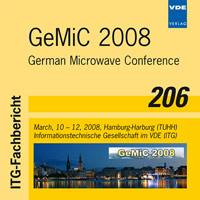Approximate Closed-Form Expressions for Nondestructive Evaluation of Dielectric Properties of Epoxy Resins and Common Liquids
Conference: GeMIC 2008 - German Microwave Conference
03/10/2008 - 03/12/2008 at Hamburg-Harburg, Germany
Proceedings: GeMIC 2008
Pages: 4Language: englishTyp: PDF
Personal VDE Members are entitled to a 10% discount on this title
Authors:
Akhtar, M. Jaleel; Feher, Lambert E.; Thumm, Manfred (Forschungszentrum Karlsruhe, Institut für Hochleistungsimpuls- und Mikrowellentechnik, D-76021 Karlsruhe, Germany)
Thumm, Manfred (Universität Karlsruhe, Institut für Höchstfrequenztechnik und Elektronik, D-76131 Karlsruhe, Germany)
Abstract:
An approximate nondestructive approach for evaluating the dielectric parameters of epoxy resins and other common liquids at 2.45 GHz is presented. The proposed method is based on the use of a commonly available glass tube of the circular cross-section, which is filled with the liquid-under-test (LUT) beforehand. The glass tube containing the LUT is then placed into the E-plane of the WR-340 rectangular waveguide for measuring the reflection and transmission coefficient data in the S-band. The approximate values of the dielectric parameters of the LUT are reconstructed from the measured scattering coefficient data in two stages. The first stage requires an extra calibration step, which involves measuring the scattering coefficient data of the empty glass tube, and then employing these measured data for normalization of the actual reflection and transmission coefficients of the LUT. In the second stage, a new kind of analytical relationship is derived here, which facilitates the determination of the effective side length of an equivalent rectangular shaped sample in terms of the inner diameter of the circular shaped glass tube containing the LUT. Finally, the dielectric properties of the LUT are reconstructed in terms of the measured normalized scattering coefficient data using the newly derived analytical relationship in combination with our earlier proposed formulation for the partially filled rectangular waveguide structures. The overall procedure is verified by measuring a number of commonly used resins and comparing our results with that of the standard numerical optimization approach.


